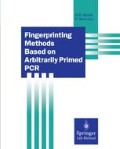Abstract
The idea of using recombinant individuals to measure linkage distance along chromosomes comes from the research of Sturtevant, in 1913, on the fruit fly, Drosophila melanogaster. Since that time, the Drosophila map has become very detailed, consisting of about 4000 mapped genes (Kafatos et al. 1991). Molecular markers, such as restriction fragment length polymorphisms, have enabled researchers to construct detailed linkage maps. This, in turn, makes it possible to identify quantitative trait loci (QTLs) that affect characters showing polygenic inheritance and to clone genes by map-based cloning techniques. Genomic maps have been used for mendelian analysis of QTLs that affect important agronomic traits of crop plants (reviewed by Tanksley 1993). QTL analysis also has been useful for mapping and cloning genes in human genetic research (reviewed by Lander and Schork 1994), for identifying loci that affect disease transmission by mosquitoes (Severson et al. 1994, 1995) and for identifying loci that influence the behavior of mammals (e.g., Carlier et al. 1990; Crabbe et al. 1994) and insects (Hunt et al. 1995).
Access this chapter
Tax calculation will be finalised at checkout
Purchases are for personal use only
Preview
Unable to display preview. Download preview PDF.
References
Carlier M, Roubertoux PL, Kottler ML, DeGrelle H (1990) Y chromosome and aggression in strains of laboratory mice. Behav Genet 20:137–156
Copeland NG, Jenkins NA, Gilbert DJ, Eppig JT, Maltais LJ, Miller JC, Dietrich WF, Weaver A, Lincoln SE, Steen RG, Stein LD, Nadeau JH, Lander ES (1993) A genetic map of the mouse: Current applications and future prospects. Science 262:57–66
Crabbe JC, Belknap JK, Buck KJ (1994) Genetic animal models of alcohol and drug abuse. Science 264:1715–1723
Estoup A, Solignac M, Harry M, Cornuet J-M (1993) Characterization of (GT)n and (CT)n microsatellites in two insect species: Apis mellifera and Bombus terrestris. Nucl Acids Res 21:1427–1431
Giovannoni JJ, Wing RA, Ganal MW, Tanksley SD (1991) Isolation of molecular markers from spécifie chromosomal intervals using DNA pools from existing mapping populations. Nucl Acids Res 19:6553–6558
Hunt GJ, Page RE Jr. (1992) Patterns of inheritance of RAPD molecular markers in the honey bee reveal novel types of polymorphism. Theor Appl Genet 85:15–20
Hunt, GJ, Page RE Jr. (1994) Linkage analysis of sex determination in the honey bee (Apis mellifera). Mol Gen Genet 244:512–518
Hunt, GJ, Page RE Jr. (1995) Linkage map of the honey bee, Apis mellifera, based on RAPD markers. Genetics 139:1371–1382
Hunt GJ, Fondrk MK, Dullum CJ, Page RE Jr. (1995) Major quantitative trait loci affecting honey bee foraging behavior. Genetics 141:1537–1545
Jansen, RC (1994a) High resolution of quantitative traits into multiple loci via interval mapping. Genetics 136:1447–55
Jansen, RC (1994b) Controlling the type I and type II errors in mapping quantitative trait loci. Genetics 138:871–881
Kafatos FC, Louis C, Savakis C, Glover DM, Ashburner M, Link AJ, Siden-Kiamos I, Saunders RDC (1991) Intergrated maps of the Drosophila genome: progress and prospects. Trends Genet 7:155–161
Kruglyak L, Lander ES (1995) A nonparametric approach for mapping quantitative trait loci. Genetics 139:1421–1428
Lander ES, Green P, Abrahamson J, Barlow A, Daly MJ, Lincoln SE, Newburg L (1987) MAPMAKER: An interactive computer package for constructing primary genetic linkage maps of experimental and natural populations. Genomics 1:174–181
Lander ES, Botstein D (1989) Mapping Mendelian factors underlying quantitative traits. Genetics 121:185–199
Lander ES, Schork NJ (1994) Genetic dissection of complex traits. Science 265:2037–2048
Lincoln SE, Lander ES (1992) Systematic detection of errors in genetic linkage data. Genomics 14:604–610
Lisitsyn N, Lisitsyn N, Wigler M (1993) Cloning the differences between two complex genomes. Science 259:946–951
Lisitsyn NA, Segre JA, Kusumi K, Lisitsyn NM, Nadeau JH, Frankel WN, Wigler MH, Lander ES (1994) Direct isolation of polymorphic markers linked to a trait by genetically directed representational difference analysis. Nature Genet 6:57–63
Martin GB, Williams JGK, Tanksley SD (1991) Rapid identification of markers linked to a Pseudomonas resistance gene in tomato by using random primers and near-isogenic lines. Proc Natl Acad Sci USA 88:2336–2340
Michelmore RW, Paran I, Kesseli RV (1991) Identification of markers linked to disease-resistance genes by bulked segregant analysis: A rapid method to detect markers in specific genomic regions by using segregating populations. Proc Natl Acad Sci USA 88: 9828–9832
Olson M, Hood L, Cantor C, Botstein D (1989) A common language for physical mapping the human genome. Science 245:1434–1435
Severson DW, Mori A, Zhang Y, Christensen BM (1994) Chromosomal mapping of two loci affecting filarial worm susceptibility in Aedes aegypti. Insect Mol Biol 3:67–73
Severson DW, Thathy V, Mori A, Zhang Y, Christensen BM (1995) Restriction fragment length polymorphism mapping of quantitative trait loci for malaria parasite susceptibility in the mosquito Aedes aegypti. Genetics 139:1711–1717
Stam P (1993) Construction of integrated genetic linkage maps by means of a new computer package: JoinMap. Plant J 3: 739–744
Sturtevant, AH (1913) The linear arrangement of six sex-linked factors in Drosophila, as shown by their mode of association. J Exp Zool 14:43–59
Tanksley SD (1993) Mapping polygenes. Ann Rev Genet 27:205–233
Williams JGK, Kubelik K, Livak J, Rafalski JA, Tingey SV, (1990) DNA polymorphisms amplified by arbitrary primers are useful as genetic markers. Nucleic Acids Res 18:6531–6535
Williams JGK, Hanafey MK, Rafalski JA, Tingey SV (1993) Genetic analysis using random amplified polymorphic DNA markers. Methods Enzymol 218:704–740
Zeng Z (1993) Theoretical basis for separation of multiple linked gene effects in mapping quantitative trait loci. Proc Natl Acad Sci USA 90:10972–10976
Zeng Z (1994) Precision mapping of quantitative trait loci. Genetics 136:1457–1468
Editor information
Editors and Affiliations
Rights and permissions
Copyright information
© 1997 Springer-Verlag Berlin Heidelberg
About this chapter
Cite this chapter
Hunt, G.J. (1997). Construction of Linkage Maps with RAPD Markers. In: Micheli, M.R., Bova, R. (eds) Fingerprinting Methods Based on Arbitrarily Primed PCR. Springer Lab Manuals. Springer, Berlin, Heidelberg. https://doi.org/10.1007/978-3-642-60441-6_22
Download citation
DOI: https://doi.org/10.1007/978-3-642-60441-6_22
Publisher Name: Springer, Berlin, Heidelberg
Print ISBN: 978-3-642-47812-3
Online ISBN: 978-3-642-60441-6
eBook Packages: Springer Book Archive

